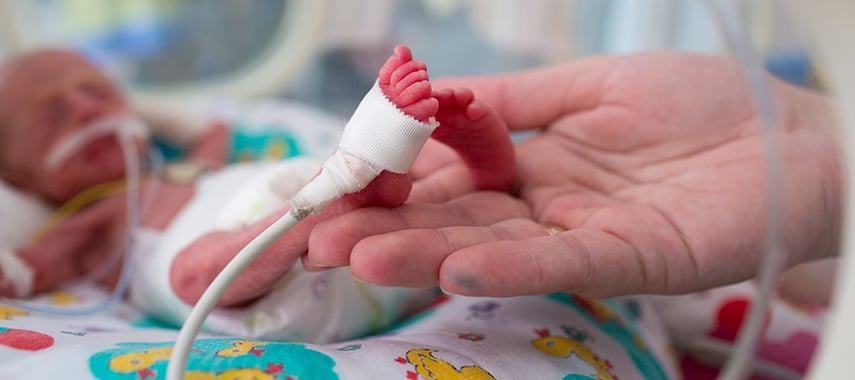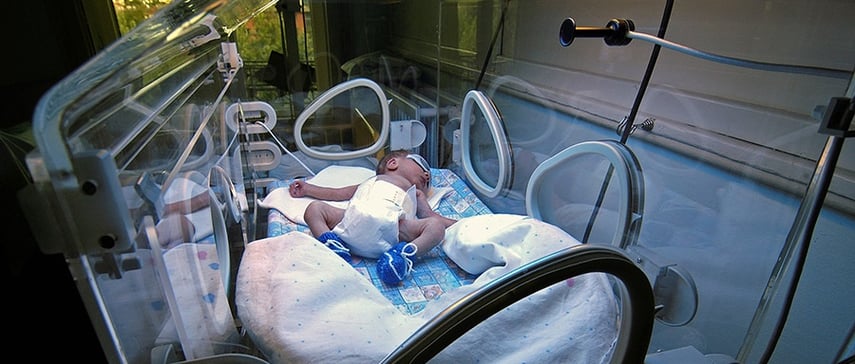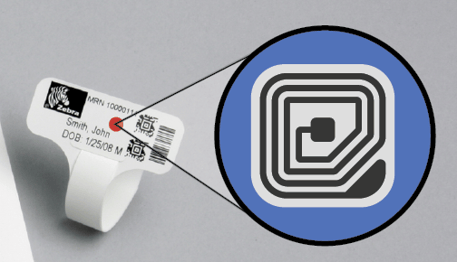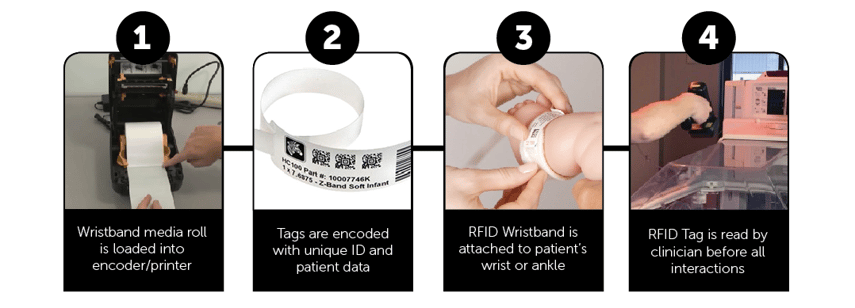\The Importance of Neonatal Identification
Throughout the healthcare industry, patient misidentification continues to be a cause of medication errors, transfusion errors, wrongperson procedures, and the discharge of infants to incorrect families.
The trends towards limiting the number of hours worked by clinical team members contributes to an increase number of people interacting with each patient, increasing the probability of communication issues.

In many cases, missing wristbands or wristbands with incorrect information were identified as the root cause of incorrect drug administration, phlebotomy, and surgical interventions.
In the neonatal intensive care unit, patient identification has added challenges. With many of the newborns being in a fragile physical state, wristbands are often attached to the isolette or intravenous tubing instead of the infant out of the desire to leave them undisturbed. This can lead to lost or detached wristbands, exposing the patient to the pitfalls we’ve mentioned previously such as incorrect medication, discharge and procedures.
often attached to the isolette or intravenous tubing instead of the infant out of the desire to leave them undisturbed. This can lead to lost or detached wristbands, exposing the patient to the pitfalls we’ve mentioned previously such as incorrect medication, discharge and procedures.
What is RFID Technology?
Radio-frequency identification (RFID) uses electromagnetic fields to automatically identify and track tags attached to objects.1
An RFID system is made up of: tags, readers, and printers/encoders. RFID tags, which are small electronic chips that include an antenna and an integrated circuit, hold data such as patient identification information. RFID readers are the devices that read the data from the tags, and can be handheld devices or fixed appliances. The RFID printer/encoder is responsible for placing the data onto the RFID tag.
How RFID Technology Helps Improve Care in the NICU
Scanning ID Bands Without Disrupting the Baby
RFID technology allows you to positively identify infants in the NICU without having to disturb them. RFID readers have the ability to read from a distance and also through materials, meaning they can read through the incubator and swaddle blankets while eliminating the potential for the scanner beam to get in baby’s eyes.
- Promotes sleeping in the NICU – Sleep is of critical importance for recovery, growth, and development of infants in the neonatal intensive care unit.
- Protects baby’s eyes – Unlike barcode scanners, RFID scanners do not have laser beams removing a potential thread to the infants eyes.
- Thermal shock - Scanning through the incubator makes it unnecessary to open the incubator, exposing the infant to thermal shock.
- Comfort first - RFID thermal wristbands meant for NICU patients are specifically engineered for comfort and contact to human skin. Available in infant sizes, these wristbands are soft and cushioned, feature hypo-allergenic adhesive, and a heat resistant top coating.
- Accurate, Durable Labeling - RFID wristbands with printed labels reduce the problem of legibility associated with handwritten wristbands as well as the potential for degrading ink quality and readability.
- Read Barcodes, Too - RFID wristbands with printed labels reduce the problem of legibility associated with handwritten wristbands as well as the potential for degrading ink quality and readability.

What type of equipment is needed for RFID patient identification?
Wristbands with RFID Inlay Tags
RFID thermal wristband materials and coatings are specifically engineered for comfort and contact to human skin. Available in infant sizing. RFID wristbands include an RFID inlay with chip and antenna, hypo-allergenic adhesive, and soft cushioning.

Handheld RFID Readers
RFID readers can quickly and easily scan barcodes in addition to RFID tags. Hospitals can choose the reader that best suits their needs, including Bluetooth®, cordless and corded versions. Bluetooth® UHF RFID readers are designed to communicate with a variety of host devices via Bluetooth® wireless technology. Readers can be configured with 2D scanning.
RFID Encoder / Printer
RFID printers will easily encode and print UHF RFID wristbands for patients of all sizes. By using an RFID wristband, your staff can verify a patients’ identity without having to move or disturb them. The ZD500R is small in size and will easily fit into your busy workstation. With automatic calibration, you’ll enjoy lower media cost, less waste and fewer roll changes.
How Does RFID Patient Identification Work?
Related to patient identification, RFID tags are encoded with patient information such as name and birth date, and embedded in a cushioned, thermal wristband. The process is similar to barcoding, with the added benefit of being able to read the information from the RFID tag from a distance, through blankets and clothing, meaning you can leave your patient completely untouched and undisturbed.
The read range, or distance from which patient id can be confirmed, is adjustable based on selected equipment and hospital needs.
When a clinician needs to administer medicine or care, they simply point the handheld RFID reader in the patients direction, and hold down the button the reader. The patient information is then displayed through the medical information system interface, which the RFID system will integrate with.
